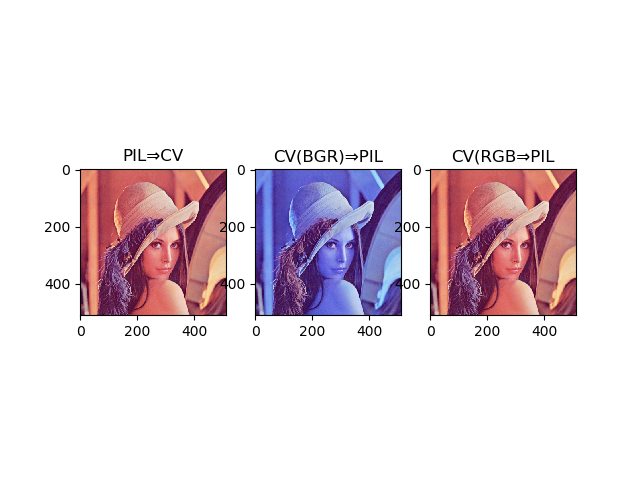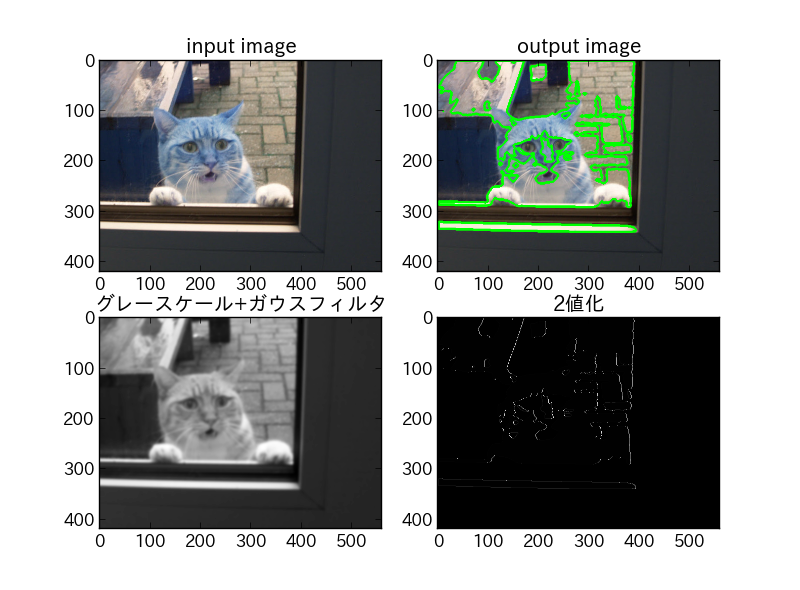python+Opencvによる画像処理11(フーリエ変換2、カラー)
2次元フーリエのコード、 numpy使うと非常に簡単でした……
import cv2 import numpy as np import pylab as plt im = cv2.imread('lena.jpg',) im1 = im[:,:,::-1].copy() im_RGB = cv2.split(im1) plt.subplot(1,4,1),plt.imshow(im1) j = 2 title = ('Red','Green','Blue') for i in im_RGB: F= np.fft.fft2(i) F_= np.log(5 + np.fft.fftshift(np.abs(F))) plt.subplot(1,4,j),plt.imshow(F_) plt.title(title[j-2]) j =j + 1 plt.show()

python+Opencvによる画像解析1(ORB特徴量)
フリーの局所画像記述子であるORBによる特徴抽出
import cv2 import numpy as np from matplotlib import pyplot as plt img = cv2.imread('lena.jpg',0) # 検出器の初期化 orb = cv2.ORB() # 特徴量の検出と出力用の計算 kp, des = orb.detectAndCompute(img, None) # 特徴の描画 img2 = cv2.drawKeypoints(img,kp,color=(0,255,0), flags=0) plt.imshow(img2) plt.show()

#検出器 cv2.SIFT() cv2.BRISK() cv2.ORB() cv2.SURF() #他にもFASTとMSERが使用可能 orb =cv2.ORB() kp = orb.detect(img) kp,des =orb.detectAndCompute(img,none) #cv2.ORB.compute() は2.4.6で動かない(バグ?)
OpenCVとPIL(python Image library)のデータ変換
2018/5/6修正
OpenCVとPILの相互利用
OpenCVとPILのデータ変換。
PIL⇒OpenCVは下で問題なし。
import numpy as np OpenCV_data=np.asarray(PIL_data)
OpenCV⇒PILは
from PIL import Image PIL_data=Image.fromarray(OpenCV_data)
青画面の残念仕様になるので対策
import matplotlib.pyplot as plt import cv2 import numpy as np from PIL import Image #OpenCVまたはPILで読み込み CV_im = cv2.imread("lena.jpg") PIL_im= np.array(Image.open("lena.jpg")) #BGRからRGBへ変換 CV_im_RGB = CV_im[:, :, ::-1].copy() #変換 PIL2CV=np.asarray(PIL_im) CV2PIL=Image.fromarray(CV_im) CV2PIL_normalize=Image.fromarray(CV_im_RGB) #描画 plt.subplot(1, 3, 1), plt.imshow(PIL2CV) plt.title(u"PIL⇒CV") plt.subplot(1, 3, 2), plt.imshow(CV2PIL) plt.title(u"CV(BGR)⇒PIL") plt.subplot(1, 3, 3), plt.imshow(CV2PIL_normalize) plt.title(u"CV(RGB⇒PIL") plt.show()

CV_im_RGB = CV_im[:, :, ::-1].copy()
最後の::-1で逆順変換、BGR⇒RGB変換を行なっている。
python+Opencvによる画像処理10(輪郭検出)
import cv2 import numpy as np import pylab as plt im = cv2.imread("cat2.jpg") im2= cv2.imread("cat2.jpg") #グレースケール im_gray = cv2.cvtColor(im, cv2.COLOR_BGR2GRAY) #ガウスフィルタ im_gray_smooth=cv2.GaussianBlur(im_gray,(11,11),0) #2値化 ret,th1 = cv2.threshold(im_gray_smooth,130,255,cv2.THRESH_BINARY) #輪郭検出 contours, hierarchy = cv2.findContours(th1,cv2.RETR_TREE,\ cv2.CHAIN_APPROX_SIMPLE) #輪郭描画 cv2.drawContours(im,contours,-1,(0,255,0),3) #描画 plt.subplot(2,2,1),plt.imshow(im2,'gray') plt.title('input image') plt.subplot(2,2,2),plt.imshow(im,'gray') plt.title('output image') plt.subplot(2,2,3),plt.imshow(im_gray_smooth,'gray') plt.title(u'グレースケール+ガウスフィルタ') plt.subplot(2,2,4),plt.imshow(th1,'gray') plt.title(u'2値化') plt.show()

cv2.adaptiveThresholdは細部まで行き届いている分、 輪郭検出には向いてなかった。パラメータの見直し等必要か。
Vagrant+VirtualBox環境の構築1
Vagrant
http://www.vagrantup.com/
VirtualBox
https://www.virtualbox.org/
仮想マシン置き場(URLコピー)
http://www.vagrantbox.es/
$vagrant box list
コマンドラインにて
#所持するboxのリスト $vagrant box list #boxの取得 $vagrant box add 任意の名前 コピーしたURL $mkdir myOS $cd myOS $vagrant init 任意の名前 $ls vagrantfile $vagrant up
vagrantコマンドの引数
status suspend resume reload#再起動 halt up destory ssh
デバッグモード
$ VAGRANT_LOG=DEBUG vagrant up
現在の環境をbox化
$vagrant pakage #package.boxが生成 #boxの追加 $vagrant add package.box 適当な名前.box
~/vagrant.d/boxesにboxファイルは保存されている。
プラグイン saharaの使用例
$vagrant plugin install sahara uninstall list $vagrant sandbox on rollback commit off
/vagrantフォルダが共有だが、仮想OSを再起動すると共有解除に。 vagrant halt⇒up必要になる。
python+Opencvによる画像処理9(2値化)
二値化法の比較。
import pylab as plt plt.rcParams['font.family'] = 'IPAexGothic' plt.rcParams['font.size'] = 12 import cv2 import numpy as np im = cv2.imread("cat.jpg") im_gray = cv2.cvtColor(im, cv2.COLOR_BGR2GRAY) #Adaptive Gaussian Thresholding th1 = cv2.adaptiveThreshold(im_gray,255,cv2.ADAPTIVE_THRESH_GAUSSIAN_C,\ cv2.THRESH_BINARY,11,2) #フィルター+大津 blur = cv2.bilateralFilter(im_gray,6,12,3) ret,th2 = cv2.threshold(blur,0,255,cv2.THRESH_BINARY+cv2.THRESH_OTSU) #フィルターのみ ret,th3 = cv2.threshold(blur,70,255,cv2.THRESH_BINARY_INV) print ret plt.subplot(2,2,1),plt.imshow(im,'gray') plt.title('input image') plt.subplot(2,2,2),plt.imshow(th1,'gray') plt.title('Adaptive Gaussian Thresholding') plt.subplot(2,2,3),plt.imshow(th2,'gray') plt.title(u"フィルター+大津") plt.subplot(2,2,4),plt.imshow(th3,'gray') plt.title(u"フィルターのみ") plt.show() cv2.waitKey(0) cv2.destroyAllWindows()

Adaptive Gaussianの圧勝っすね。
参考(というかそのまま)
http://opencvpython.blogspot.jp/2013/05/thresholding.html
matplotlib、pylabで日本語+フォント変更
ここを見ながら実施
http://www.sakito.com/2012/01/matplotlib.html
matplotlib.matplotlib_fname()
でmatplotlibrcの場所を調べる。
$copy C:/python/site-packages/matplotlib/mpl-data/matplotlibrc ~/.matplotlib
~/.matplotlib/matplotlibrcに下記を記載する。
font.serif : MSGothic
font.sans-serif : MSGothic
import pylab as plt plt.rcParams['font.family'] = 'MSGothic'
と入れること。